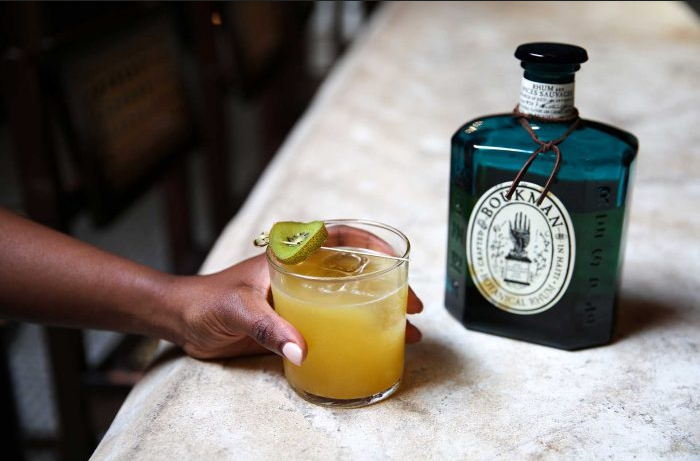What is botanical rum?
Basically, it’s rum that’s flavored with botanicals like fresh or dried herbs, spices and edible flowers. Usually, the base is white rum. And, like most types of rum, there are no geographical restrictions, so it can be made pretty much anywhere.
If this definition sounds a bit fuzzy, that’s because it doesn’t have an official category. The few available in the U.S. are classified as “flavored rums” or “specialty spirits” under distilled spirits regulatory guidelines.


How is it different from spiced rum?
The short answer: It has little to no vanilla, and little to no sweetener.
Spiced rum, also usually categorized as a “flavored rum,” typically starts with an aged spirit base and is flavored predominantly with baking spices, notably vanilla, but also allspice, clove or cinnamon. It’s often sweetened as well.
Botanical rum tends to be lighter and drier, some say “greener,” in flavor. Instead of baking spices, flavorings tend to be more herbaceous or floral, though spices and barks are often part of the mix, too.


How is it different from gin?
Botanical rum also shares some similarities with gin, and many producers encourage drinking mixing it with tonic, G&T style. But it differs in two key ways.
First, botanical rums usually exclude juniper, a required flavoring for gin.
Second, the base of a botanical rum needs to be rum, which means that it must be distilled from a sugarcane product. Most gins start with a neutral spirit, most often distilled from grain. However, there are gins distilled from sugarcane, and there’s no rule that botanical rum can’t include juniper. So overlap is certainly possible.


Where did botanical rums come from?
This type of rum seems to have multiple origins and inspirations.
Haiti’s Boukman Botanical Rhum, launched in 2016, is technically a style of clairin, specifically clairin trempé (translated as “botanical rhum”). It starts with a base of rhum agricole, distilled from sugarcane juice instead of molasses. That’s infused with a mix of 11 botanicals that include native woods and barks, bitter orange peel and bitter almond.
“We’re more of a street-style drink, infused with barks and botanicals,” says Boukman cofounder Adrian Keogh. He sought to bring a version of clairin trempé to a global audience. Across South and Central America, he says, there’s a longstanding tradition of infused rums.
In 2019, Washington, D.C. bartender Todd Thrasher created Thrasher’s Green Spiced Rum in an effort to build a rum suitable to pair with tonic. The blackstrap molasses-based spirit is distilled at his Potomac Distilling Company, and it’s flavored with botanicals like lemon balm, lemon verbena, lemon balm, mint, lime peel and green cardamom.


While inspired by herbs grown in his backyard, he now grows them in a rooftop garden atop the distillery. At his Tiki TNT bar, the spirit is served in mojitos and tropical drinks.
In California’s Bay Area, Callisto launched in 2020 with a “California dry”-style botanical rum. Giles Templeman, the company’s cofounder and CEO, grew up in Bermuda (home to Gosling’s) and had an affinity for rum. He was drawn by the fact that the rum category has few restrictions.
“With that in mind, we said, ‘We can flavor rum with anything,’” says Templeman. “We said, what would be super cool would be to flavor our rum with locally sourced California botanicals.
Callisto starts with a blend of Trinidad and Nicaragua rums, transferred to Petaluma, where it’s infused with botanicals like rosemary, lavender, burdock root and cherry bark.
Botanical rums have also picked up speed across the Atlantic. Five Hundred Cuts Botanical Rum, from the U.K. brewery Brewdog, is fermented with red wine yeast and flavored with tonka bean, lavender and clove.
In Holland, Amsterdam’s Spirited Union makes five fruit-forward varieties that include a blush-hued Pink Grapefruit and Rose bottling.
Even Cuban icon Havana Club has released a Verde rum infused with orange peel and mint. It’s currently available only in Germany.
“Botanical rum is an open space to innovate,” says Templeman. “There’s a ton of bases and botanicals to work with.”
For now, it’s still a relatively niche product. It may never become mainstream like spiced rum. However, Templeman says, “there’s an open ocean for the category to grow.”


What does botanical rum taste like?
Most are relatively light and emphasize herbaceous, floral or fruity flavors. Botanical rums tend to be unsweetened. The few that use sweeteners generally use a minimal amount.
Each tastes a little different, which depends on the base rum and the botanicals used. Here are three available in the U.S. to try:
Boukman Rhum (Haiti; $48): Golden hue and intense, root-like aroma. The flavor is reminiscent of spiced rum. It shows cinnamon and grilled banana, sprinkled with brown sugar. It finishes with mellow funk.
Callisto California Dry Botanical Rum (USA; $33): This clear spirit has a light floral aroma similar to some gins, but the full-bodied texture reminds that it’s rum. Expect herbaceous sage and lemongrass. The finish offers piquant peppercorn sizzle.
Thrasher’s Green Spiced Rum (USA; $27): “Green” refers to the garden herbs used to flavor this brisk, malty rum. The rum has the faintest straw tinge. Look for slight coconut sweetness on the palate and whispers of dill and mint.


